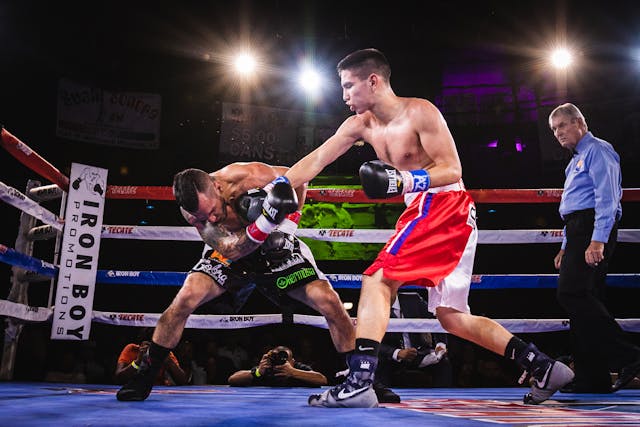
What are the Queensberry rules? They are the rules for boxing published in 1867 and endorsed by the 9th Marquess of Queensberry.
People have fought each other for as long as there have been people. Over time, fighting turned into a sport. The Romans had their gladiators and many other societies turned out in their thousands to watch people fight. Gradually, they realized that if fighting was going to be a sport, it needed rules. Even the gladiator fights in Rome had strict rules. Boxing is a sport that has existed for millennia. An Egyptian sculpture from 1350 BC shows a boxer and an audience. Romans boxed with leather strips wrapped around their fists to protect them. When the Romans left Western Europe, the sport carried on. As the tradition of knights died out, people started to fight more with their fists than with swords.
By the time of the Industrial Revolution, more people were living in towns and boxing was a very popular sport. There were no real rules and people of different heights fought using eye gouges, headbutting, and throws. Jack Broughton, a champion fighter, decided to come up with some rules, which are the first known rules of boxing. They were called the Broughton rules. We wouldn’t recognize any of them now and they deal a lot with what the seconds should do and how the winnings should be counted out in public. A second is the trusted representative of the fighter. He also tried to get people to use gloves, but they didn’t take on.
In 1838, the rules were updated and the London Prize Ring Rules were brought in. There were 29 of them and we still use a few today. Under these rules, bare-knuckle fighting was still the norm and the matches were very long and very vicious. Boxing became stigmatized as an uncivilized activity only for the working classes.
In the 1860s, a sportsman called John Graham Chambers decided to do something about the image of boxing. He had two reasons for this. Firstly, boxing was considered to be uncivilized. Secondly, bare-knuckle fighting in public had been banned to prevent violence. Chambers knew the only way to improve the sport was to get people to wear gloves. He came up with 12 rules:
1. To be a fair stand-up boxing match in a twenty-four foot ring or as near that size as practicable.
2. No wrestling or hugging allowed.
3. The rounds to be of three minutes duration and one minute time between rounds.
4. If either man fall through weakness or otherwise, he must get up unassisted, ten seconds be allowed to do so, the other man meanwhile to return to his corner; and when the fallen man is on his legs the round is to be resumed and continued until the three minutes have expired. If one man fails to come to the scratch in the ten seconds allowed, it shall be in the power of the referee to give his award in favour of the other man.
5. A man hanging on the ropes in a helpless state, with his toes off the ground, shall be considered down.
6. No seconds or any other person to be allowed in the ring during the rounds.
7. Should the contest be stopped by any unavoidable interference, the referee (is) to name the time and place as soon as possible for finishing the contest, to that the match can be won and lost, unless the backers of the men agree to draw the stakes.
8. The gloves to be fair-sized boxing gloves of the best quality and new.
9. Should a glove burst, or come off, it must be replaced to the referee’s satisfaction.
10. A man on one knee is considered down, and if struck is entitled to the stakes.
11. No shoes or boots with springs allowed.
12. The contest in all other respects to be governed by the revised rules of the London Prize Ring.
His rules introduced fighting with gloves, the three minute rounds, and the count of ten. He removed all non-boxing moves as well, making the sport much more standardized. His rules were popular, but he needed help to get them. Chambers was a member of the Amateur Athletic Club that had been founded by John Sholto Douglas, 9th Marquess of Queensberry. The club published Chambers’ 12 rules for boxing in 1867 and the marquess sponsored them to give them backing. As the rules were picked up, they became known as the Marquess of Queensberry rules and then just the Queensberry rules.
The Queensberry rules are all about fighting fairly and sportsmanship, which is ironic because the Marquess of Queensberry was a very unsportsmanlike person. He was rude, violent, had affairs, hated his children and fought with them, was involved in numerous scandals that made the front pages, and possibly mentally ill. However, above all that, he is the reason why Oscar Wilde was imprisoned and died at the young age of 46. He called Oscar Wilde a sodomite in public and Wilde took him to court to sue for libel. That was a mistake, because it meant the Marquess of Queensberry had to prove that Wilde engaged in homosexual acts, which he managed to do fairly easily. Wilde lost that case, was bankrupted, then charged by the state and sentenced to two years of hard labor, which ended up killing him. And this is what I learned today.
Photo by Sides Imagery: https://www.pexels.com/photo/boxers-inside-a-ring-3531081/
Sources
https://en.wikipedia.org/wiki/Marquess_of_Queensberry_Rules
https://en.wikipedia.org/wiki/John_Graham_Chambers
https://en.wikipedia.org/wiki/London_Prize_Ring_Rules
https://en.wikipedia.org/wiki/Broughton_Rules
https://en.wikipedia.org/wiki/Boxing
https://en.wikipedia.org/wiki/John_Douglas,_9th_Marquess_of_Queensberry
https://en.wikipedia.org/wiki/Oscar_Wilde
https://www.qrulesboxing.com/history
https://boxingnewsonline.net/the-marquess-of-queensberry-the-man-who-broke-the-rules
https://www.history.com/news/10-things-you-may-not-know-about-roman-gladiators
https://www.etymonline.com/word/boxing
https://www.wbaboxing.com/boxing-news/almost-160-yearsof-the-12-rules-of-boxing
